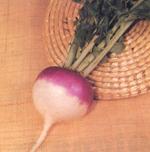| Fruits |
Vegetables
|
Turnip, Brassica rapa / Cruciferae (Brassicaceae)
|
Note: Composition for 100 g. of fresh product Values in ( min. - max. ) format. | |
| Energy: 18.00-24.58 kcal Fats: 0.22-0.40 g Fibres: 2.40-3.49 g Fat Acids Polyunsat.: 0.20-0.20 gMinerals Calcium: 12.00-49.40 mgZinc: 0.100-0.230 mg Chlorine: 39.00-70.00 mg Phosporus: 7.00-41.00 mg Iron: 0.200-0.440 mg Magnesium: 7.40-10.00 mg Manganese: 0.068-0.100 mg Potasium: 238.00-318.00 mg Selenium: 1.00-3.10 µg Sodium: 15.00-58.00 mg Iodine: 7.50-9.50 µg | Proteins: 0.40-0.99 kcal Carbohidrates: 3.30-4.70 g Liposoluble Vitamins A Retinol: 0.00-12.0020.00-72.00 µgLiposoluble Vitamins B1 or Thiamine: 0.040-0.50 mgB2 or Riboflavine: 0.010-0.051 mg B3 or Niacine: 0.40-0.90 mg B5 or Pantothenic Acid: 0.200-0.200 mg B6 or Piridoxine: 0.080-0.080 mg B9 or Folic Acid: 17.00-20.00 mg C or Ascorbic Acid: 17.00-20.00 mg |

Turnip is the root of the plant with the same name. It belongs to the same botanical genus as cabbages and it is eaten as a vegetable. The roots of the different varieties have different size, shape and colour. The ‘flesh’ is white and covered with a thin yellow or white skin, sometimes green or purple. It has a round, flat-top or cylindrical shape.
Nutrition and eating
Turnips have a scarce nutritious value. They contain very few proteins, carbohydrates and fats. For that reason it is consumed in slimming diets.
However, it is extremely rich in minerals and vitamins. It provides with a significant amount of vitamin C and folic acid. Among the minerals found in this vegetable stands out its content in potassium (238-318 mg for each 100 g of fresh produce), and in a smaller amount, calcium, phosphorus, iodine and sodium.
However, it is extremely rich in minerals and vitamins. It provides with a significant amount of vitamin C and folic acid. Among the minerals found in this vegetable stands out its content in potassium (238-318 mg for each 100 g of fresh produce), and in a smaller amount, calcium, phosphorus, iodine and sodium.
The fruit
 Turnip (Brassica rapa var. Rapa) is the root of the plant with the same name. It belongs to the same botanical genus as cabbages and it is eaten as a vegetable. The roots of the different varieties have different size, shape and colour. The ‘flesh’ is white and covered with a thin yellow or white skin, sometimes green or purple. It has a round, flat-top or cylindrical shape.
Turnip (Brassica rapa var. Rapa) is the root of the plant with the same name. It belongs to the same botanical genus as cabbages and it is eaten as a vegetable. The roots of the different varieties have different size, shape and colour. The ‘flesh’ is white and covered with a thin yellow or white skin, sometimes green or purple. It has a round, flat-top or cylindrical shape. It is chiefly cultivated for its bulbous root although the leaves are also eaten as green vegetables. This root has scarce nutritional properties, 6% of glucids and not even 1% of protein matter.
It has a discreet importance in the cooking field. However, it has a soothing role in multiple dishes and it is found in several stews, it is an important ingredient of the Spanish ‘cocido madrileño’ and "cocido canario’.
Its consumption has suffered a significant decrease in the European countries, where long ago, and along with cabbage, it was the most popular vegetable of the Nordic and Central European countries; it has been replaced by the potato.
Turnips have a low caloric content, only 18-24 kcal for each 100 g of edible produce.
Once at home, they are kept in the fridge, in perforated bags, for 1-3 weeks. The storage lengthens if they are frozen, although previous to that it is recommended to scald them for 2 minutes, already cooked or in purée.
From the turnip’s pressed seeds we obtain an edible oil that is used for cooking in Europe and India. Turnips are traded dehydrated, by means of water elimination of the roots in fresh condition, previously cut up in dices.
The plant
The turnip plant belongs to the Cruciferae family and its scientific name is Brassica napus L. It is an erect, biennial plant, with cleaved leaves of scalloped edges. The flower stem is even and the flowers are of a yellow colour. The pollination is allogamous. The fruition is siliquous.
The seeds are round, of dark reddish colour. The weight of one thousand seeds is 1.6 grams; the average germination capacity is around 4 years.
The root system is swollen, and there are two different types, the globulose and the elongate. The colour varies from white to red. Great part of the Spanish production of turnip for cattle fodder belongs to the variety "Nabo gallego’, whose neck resembles that of Swedish turnip although it is shorter and more conical. The leaves of the "Nabo gallego’ are used in several stews of the Galician cooking and they are known as "grelos".
The seeds are round, of dark reddish colour. The weight of one thousand seeds is 1.6 grams; the average germination capacity is around 4 years.
The root system is swollen, and there are two different types, the globulose and the elongate. The colour varies from white to red. Great part of the Spanish production of turnip for cattle fodder belongs to the variety "Nabo gallego’, whose neck resembles that of Swedish turnip although it is shorter and more conical. The leaves of the "Nabo gallego’ are used in several stews of the Galician cooking and they are known as "grelos".
| Interempresas Media, S.L. / 2026 | [ Legal notice | Política de Protección de Datos | Política de cookies | Publicidad] |
